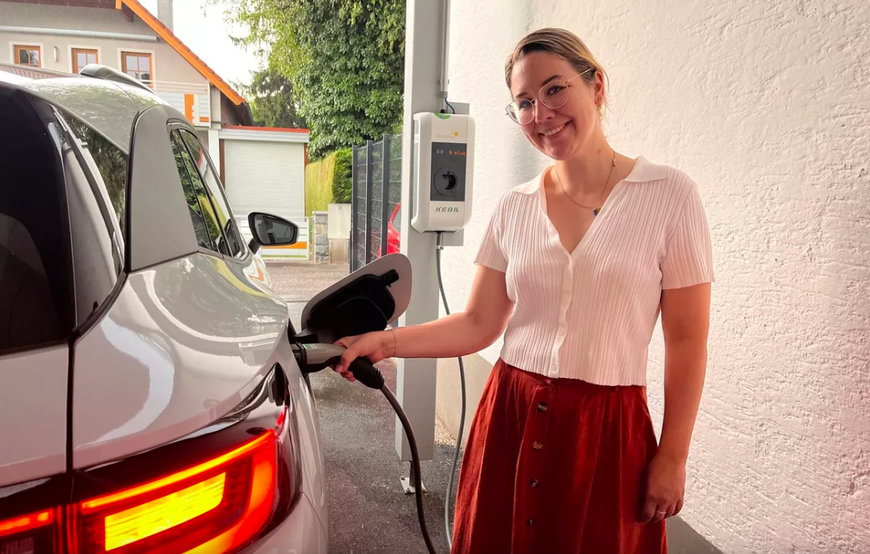smartbuildingmag.com
07
'23
Written on Modified on
WALLBOX FOR PV SURPLUS CHARGING IN PRIVATE NEW BUILDS
Elisa and Roland have built a new house. It was clear to them that a PV system had to be installed on the roof and that it should also charge the electric car directly. To ensure this works smoothly, they opted for a complete solution from KEBA.

Elisa and Roland now have a new address. The two have built a house on the outskirts of Linz. There was no doubt that a photovoltaic system should be installed on the roof - in order to do something for the environment and to use less externally produced electricity. After all, their house is heated by a heat pump and they also have an electric car.
The Task: Charging with PV electricity - simply and as efficiently as possible
The photovoltaic system on the roof has a peak output of 8.25 kW. In summer, of course, this produces much more electricity than the modern building needs. But since the energy hunger of Elisa's and Roland's home is really manageable, there should be more PV electricity during the day in spring and autumn than the cooker, washing machine and other appliances consume during this time. To avoid feeding this PV surplus exclusively into the grid, the couple looked for an uncomplicated solution to charge their electric car at home with as much solar power as possible. Because the remuneration from the grid operator is lower than the price they pay to purchase electricity, the homeowners want to save money and cover the majority of their trips with self-produced energy. "Sustainability is important to us. And then, above all, simple operation," was Roland’s goal and requirement for the charging station and accessories.
The Implementation: Thanks to PV Edition Set, maximum sunshine in the battery
"It was clear to us from the start that we wanted to use the surplus from the PV system as efficiently as possible," Roland tells us, and Elisa adds, "It's also important that things work smoothly and, above all, that you don't always have to look things up or fiddle around with things yourself." This is exactly where the complete solution from KEBA comes in: The KeContact E10 Smart Energy Meter, which is part of the PV Edition Set, measures the current energy demand of the house. If this is less than the current output of the PV system, the surplus is made available to the charging station and thus to the e-car. The KeContact S10 Phase Switching Device is also part of the solution. This component makes it possible to charge in single-phase mode instead of the usual three-phase mode. This is particularly advantageous in the darker seasons or when it is cloudy. If the PV surplus is then very low, you can still 'fill up' the e-car with sunshine - and thus use the last bit from your own power plant yourself.
Interaction with KEBA wallbox and app
Of course, the KeContact P30 PV Edition wallbox is also part of the set. It communicates with E10 and S10 from Elisa and Roland's carport. Together they are the trio that maximises PV charging. And of course, the KEBA app can also be used to set the minimum charging current when the car is plugged in: because if nothing or very little is coming from the roof, but you need to charge, the battery will still be full via additional mains current - thanks to the boost function also at maximum charging speed.
It took a while to get an appointment with the electrician, but then installation and set-up were quickly done. Incidentally, Elisa and Roland found their electrician via the partner search function on the KEBA website - he therefore has the corresponding certification and experience.

The Result: The e-car can be charged with a surplus.
On the one hand, the young homeowners are pleased with the simplicity: "It's fine that you basically don't have to think about anything - it just works." On the other hand, the balance is astonishing: "It's great that our car can be charged almost only with PV surplus." And that's with a PV system of normal household dimensions that provides 8,000 to 9,000 kWh per year. For those who can't believe it: An average electric car consumes 20 kWh/100 km. With an annual mileage of 10,000 km, that's only 2,000 kWh. From a purely mathematical point of view, especially if the vehicle charges frequently at home when the sun is shining, e.g. in the case of extensive home office use - it would even be possible to achieve double the amount and charge a second e-car.
Any other wishes?
Elisa, a graphic designer by profession, knows what she still needs: "My self-designed cover! I'm looking forward to having that done at KEBA too."
www.keba.com

